
The Storm's Unprecedented Fury
A massive storm system wreaked havoc across the United States over the weekend, leading to at least 34 confirmed deaths. This devastating tornado outbreak, combined with raging wildfires, showcased the frightening power of nature in March 2025. Fatalities were recorded across multiple states including Missouri, Kansas, Arkansas, and Mississippi, with Missouri suffering the highest toll. Deaths were primarily attributed to tornado strikes that obliterated homes and businesses, while others were linked to flash floods and collapsing structures.
Visual Havoc: Images of Destruction
The aftermath of this storm yields heartbreaking visuals. In Missouri, homes were reduced to debris fields, and families like Dakota Henderson’s found themselves sifting through ruins, recounting harrowing tales of survival. “Just a debris field,” described Coroner Jim Akers of Butler County—a fitting statement reflecting the wreckage in places like Wayne County, Missouri, where multiple fatalities occurred. As communities begin to assess damages and support those affected, these poignant images serve as reminders of the storm's catastrophic nature.
Surge in Severe Weather: What’s Driving It?
The National Weather Service indicated that such severe weather incidents are not unusual for March but noted the exceptional intensity and breadth of this particular outbreak. Experts attribute it to a variety of climate factors, including a jet stream that has created conditions ripe for tornado formation. The storm resulted in wind gusts up to 80 mph in some areas, contributing to the extensive damage beyond the tornado paths. The impact of such winds is worsened by the dry conditions that have ignited wildfires throughout the southern plains, leading to further fatalities.
Community Response: Resilience in the Face of Disaster
As states like Arkansas and Georgia declared emergencies to facilitate recovery efforts, communities banded together to provide immediate support to victims. Emergency services worked tirelessly to deliver aid, while citizens opened their homes to those displaced. Rescues became a graphic display of human effort as many, like Henderson, endeavored to locate family members amid the destruction. Such poignant examples of support highlight the uplifting spirit that often follows natural calamities.
The Future: Are We Prepared?
This storm's tragic toll raises critical questions about preparedness and response measures in the face of increasingly violent weather patterns. Moving forward, experts stress the importance of community awareness and preparedness. Engaging citizens in storm drills and investing in infrastructure to mitigate damage from flooding and tornadoes is vital. Additionally, creating national strategies for effective emergency response could save lives and property in future storm events.
Call to Action: Staying Informed and Prepared
The recent storms have reminded us all of nature's unpredictable power. As meteorologists track new weather systems emerging across the country, it is crucial to stay informed. Residents in vulnerable areas should follow local alerts, participate in preparedness drills, and have an emergency plan in place. Share this information within your community—we can all contribute to reducing the risk and enhancing response efforts for similar events in the future.
 Add Row
Add Row  Add
Add 




Write A Comment